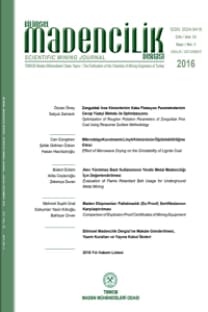Alkali Aktive Edilmiş Uçucu Külün Sinterlenmesi, Karakterizasyonu ve Fiziksel Özelliklerinin İncelenmesi
Bu çalışmada, Sivas Kangal Termik Santrali’nden edinilmiş uçucu külden yapılan alkali aktivasyon yani jeopolimerleşmenin ardından, farklı sıcaklıklarda sinterlenmesi ile üretilen numunelerin mekanik özellikleri, toz özellikleri, termal özellikleri ve faz özellikleri tartışılmıştır. Mekanik özellikler için basma testi, termal özellikler için geçirgen plaka kaynağı ölçümü, yüzey ve toz özellikleri için taramalı elektron mikroskobu ve faz analizi için X-ışınları difraksiyonu kullanılmıştır. Yapılan çalışmalarda kolay bulunan ve silika kaynağı da olabilen bir alkali olan Na2SiO3 farklı molaritelerde kullanılmış ve özellikleri incelenmiştir. Uçucu külün hem jeopolimer olarak kullanılabilirliği, hem de sinterlenmiş malzemenin yüzey plakası olarak kullanılabilirliğinin olduğu sonucuna varılmıştır. Basma mukavemeti 10 MPa, termal iletkenliği 0.0006 W/m.K, belirlenen fazlar ise kalsiyum silikat, kalsiyum aluminate, amorf silika ve magnezyum alüminat ve sinterleme ürünü olan camsı kyanite yani aluminasilikat fazı görülmüştür.
Anahtar Kelimeler:
Uçucu Kül, Jeopolimer, Sinterleme, Termal iletkenlik, Mekanik Özellikler
Investigation of sintering, characterization and physical characteristics of alkali activated fly ash
In this study, mechanical properties, powder properties, thermal properties and phase properties of samples produced by sintering at different temperatures after alkali activation by geopolymerization, made from fly ash obtained from Sivas Kangal Thermal Power Plant, are discussed. Compression test for mechanical properties, transient plane source measurement for thermal properties, scanning electron microscopy for surface and powder properties, and X-ray diffraction for phase analysis wasa evaluated. In studies, Na2SiO3, an alkali that can be found easily commercially and a source of silica, was used at different molarities and its properties were investigated. It was concluded that fly ash can be used both as a geopolymer and as a sintered material as a lateral plate as well as brick production. Compressive strength was found to be as 10 MPa, thermal conductivity is 0.0006 W/m.K, and the determined phases are calcium silicate, calcium aluminate, amorphous silica and magnesium aluminate and glassy kyanite which is a sintering product, namely aluminacilicate phase.
Keywords:
Fly Ash, Geopolymer, Sintering, Thermal Conductivity, Mechanic Properties,
___
- Binici H., Aksogan, O., Çagatay, I.H., Tokyay, M., Emsen E. 2007. The effect of particle size distribution on the properties of blended cements in- corporating ggbfs and natural pozzolan (NP). Powder Technology, 177 (3), 140–147.
- Binici, H., Aksogan, O., Kaplan, H., Gorur, E.B., Bodur M.N. 2008. Perfor- mance of ground blast furnace slag (GBS) and ground basaltic pumice (GBP) concrete against seawater attack. Construction and Building Materials, 22, 1515–1526.
- Binici, H., Aksogan, O., Kaplan, H., Görur, E.B., Bodur, M.N. 2009. Hy- dro-abrasive erosion of concrete incorporating ground blast-furnace slag and ground basaltic pumice. Constructer Build Mater, 23, 804–11.
- Hodhod, O.A., Alharthy, S.E., Bakr, S.M. 2020. Physical and mechanical properties for metakaolin geopolymer bricks. Construction And Building Materials, 265, 1202-1217.
- Mahmoodi, O., Siad, H., Lachemi, M., Dadsetan, S., Sahmaran, M. 2021. Development of normal and very high strength geopolymer binders based on concrete waste at ambient environment. Journal Of Cleaner Production, 279, 1234-1236.
- Massazza, F. 2001. Pozzolana and pozzolanic cements. Lea’s Chemistry of Cement and Concrete, Butterworth-Heinemann, 471–636.
- Şaşmaz, A. Sağıroğlu A. 1994. Tutak Dağı Güneybatısındaki (Şebinkarahisar-Giresun) Pb-Zn yatakları. MTA Dergisi, 116, 51-64.
- Van Oss, H.G., Padovani A.C. 2003. Cement manufacture and the environ- ment part ii: environmental challenges and opportunities. Journal of Industrial Ecology, 7(1), 93–126.
- Zhang, W., Zhang Y., Zhang, G. 2011. Single and multiple dynamic impacts behaviour of ultra-high performance cementitious composite. J Wu- han Univ. Technology-Materials Science Edition, 26 (6), 1227–1234.
- Zhang, W., Zhang, Y., Zhang, G. 2012a. Continuously monitoring early hy- dration process of low water to binder ratio cementitious material at elevated temperatures using a newly developed non-contact resistivi- ty measurement apparatus. Construction Build Mater, 33, 32–40.
- Zhang, W., Zhang, Y., Zhang, G. 2012b. Static, dynamic mechanical prop- erties and microstructure characteristics of ultra-high performance cementitious composite. Science and Engineering of Composite Ma- terials,19, 237–45.
- ISSN: 2564-7024
- Yayın Aralığı: Yılda 4 Sayı
- Yayıncı: TMMOB Maden Mühendisleri Odası
Sayıdaki Diğer Makaleler
Düşük tenörlü barit cevherinin (Kozan/Adana) zenginleştirilmesinin araştırılması
Oktay BAYAT, Zehra ALTINÇELEP, Mahmut ALTINER
Mete Tayhan SERDENGEÇTİ, Bekir BAŞKURT, Kaan ÖZÇELİK, Hüseyin BAŞTÜRKCÜ
Yeni yaylı plaka kullanımı ile sürtünmeli kaya saplamaları performanslarının iyileştirilmesi
Kaya kütle makaslama dayanımının geri analiz yöntemi ile belirlenmesi: Bir vaka analizi
